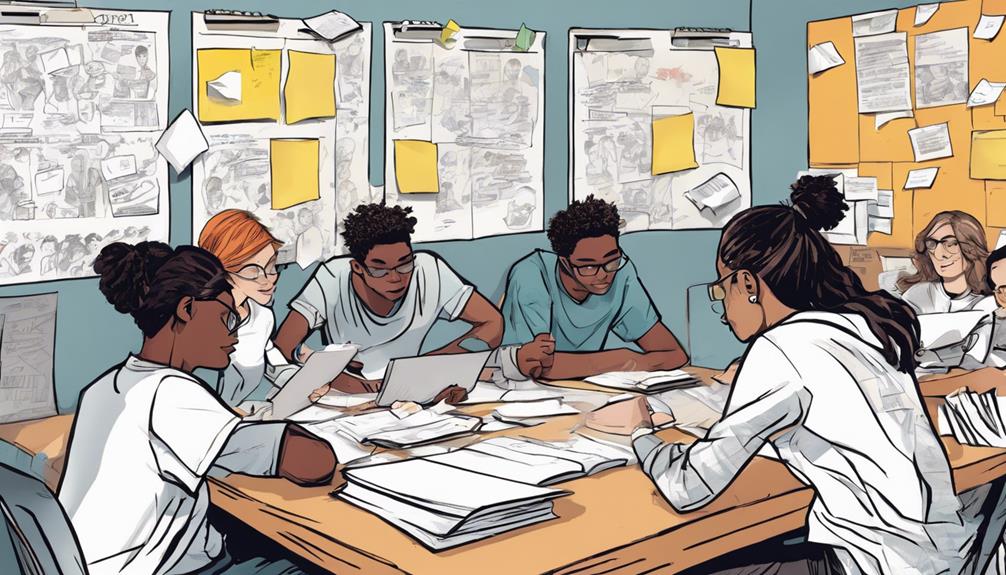Hey there, high school students! Have you ever considered learning about the Scrum method? It can truly revolutionize your approach! By implementing Scrum, you will improve your collaboration, time management, and adaptability skills. Just picture breaking down tasks into manageable sprints, holding daily meetings to monitor progress, and facing challenges as a united team. Your communication, problems solving, and productivity will skyrocket with each sprint. Moreover, celebrating achievements with mini victory parties will keep you motivated and fulfilled. Embrace Scrum to unlock your full potential and pave the way for success in school and beyond!
Key Takeaways
- Scrum method enhances collaboration skills in high school students.
- It fosters effective teamwork and time management abilities.
- Breaking projects into sprints boosts engagement and project completion.
- Roles like Product Owner and Scrum Master introduce real-world project dynamics.
- Daily Scrum meetings track progress, resolve issues, and promote accountability.
Benefits of Scrum for High School Students

High school students greatly benefit from the Scrum method by fostering collaboration, time management, and adaptability skills essential for their academic and professional growth.
Through Scrum, you learn to work together like a well-oiled machine, juggling tasks, deadlines, and changes like a pro. Imagine tackling a project with your classmates, each playing an essential role like a superhero team saving the day.
With Scrum, you become a time management wizard, slicing tasks into manageable bits and conquering them one sprint at a time. Adaptability becomes your middle name as you pivot, adjust, and excel in the face of challenges.
Implementing Scrum in the Classroom

Implementing Scrum in the classroom enhances student engagement and fosters effective teamwork skills. By breaking projects into manageable sprints, you learn to tackle tasks step by step.
Imagine pitching your project ideas and working as a team with specific roles like Product Owner and Scrum Master – it's like being part of a professional team!
Daily Scrum meetings keep everyone on track and help address any roadblocks quickly. Plus, the feedback loops in Scrum mean you're always improving based on suggestions from peers and teachers.
Showcasing your achievements at the end of each sprint not only boosts your motivation but also gives you a sense of accomplishment. Get ready to thrive in your projects with Scrum!
Enhancing Collaboration Through Scrum

Enhance student collaboration skills through the implementation of Scrum methodology in the classroom, fostering a dynamic environment for teamwork and project success. By working in small, dedicated teams with clear roles like Product Owner, Scrum Master, and Developer, you learn to communicate effectively and support each other's strengths. Embrace daily Scrum meetings to update progress and tackle challenges together. Check out the table below to see how Scrum enhances collaboration:
| Benefits of Scrum Collaboration | Description |
|---|---|
| Improved Communication | Regular interactions enhance teamwork. |
| Enhanced Problem-Solving Skills | Collaborative problem-solving boosts creativity. |
| Shared Accountability | Team members hold each other accountable. |
| Increased Productivity | Collective effort leads to efficient outcomes. |
Developing Adaptability Skills With Scrum

Through the Scrum methodology, you develop essential adaptability skills by embracing feedback loops and iterative processes. In Scrum, you constantly receive feedback from peers and teachers, helping you refine your work and improve.
This means you get to adjust your project based on what you learn along the way, making it better each step of the journey. Imagine it like a video game where you keep leveling up as you gain new skills and insights!
Celebrating Successes With Scrum

You can mark the completion of each sprint by showcasing your achievements and celebrating your successes with the Scrum method. It's like throwing a mini victory party after reaching a milestone in your project!
Imagine displaying your prototypes, sharing your data analysis findings, or presenting your project advancements to your peers and teachers.
This celebration isn't just about patting yourself on the back – it's a chance to recognize your hard work, creativity, and problem-solving skills.
By celebrating your successes, you're not only boosting your motivation but also fostering a sense of accomplishment that will drive you forward in the next sprint.
Frequently Asked Questions
How Does Scrum Help Students Manage Their Time Effectively?
In Scrum, you manage time effectively by breaking projects into sprints with clear goals, having daily meetings for updates, utilizing feedback loops, and adapting based on input. It fosters collaboration, coordination, and continuous improvement.
What Are Some Challenges Students Might Face When Using Scrum?
When using Scrum, you might face challenges like time management, task prioritization, and adapting to changes. Stay focused on clear goals, communicate effectively in daily meetings, and embrace feedback for continuous improvement.
Can Scrum Be Adapted for Group Projects With Varying Skill Levels?
You can adapt Scrum for group projects with varying skill levels by assigning roles based on strengths, fostering collaboration, and providing support for skill development. Embrace diversity to create a dynamic and inclusive team environment.
How Does Scrum Prepare Students for Real-World Project Management?
Imagine a puzzle coming together piece by piece. Scrum equips you with real-world project skills through sprints, daily meetings, feedback loops, and showcasing results. It's like training for a marathon: gradual progress leads to success.
What Resources Are Available to Support Teachers in Implementing Scrum?
To support teachers in implementing Scrum, utilize online guides, workshops, and coaching sessions. These resources offer practical tips, templates, and strategies. Engage with a community of educators to share experiences, troubleshoot challenges, and enhance student learning outcomes.
Conclusion
To sum up, the Scrum method is like a secret weapon that turns high school students into unstoppable collaboration champions, adaptability wizards, and success superstars.
So, buckle up, because with Scrum by your side, you're ready to conquer any challenge that comes your way.
Keep sprinting towards your goals, celebrating every victory along the way, and embracing the power of teamwork and growth.
The world is your oyster, and Scrum is your trusty sidekick on this exciting journey of discovery and achievement!










